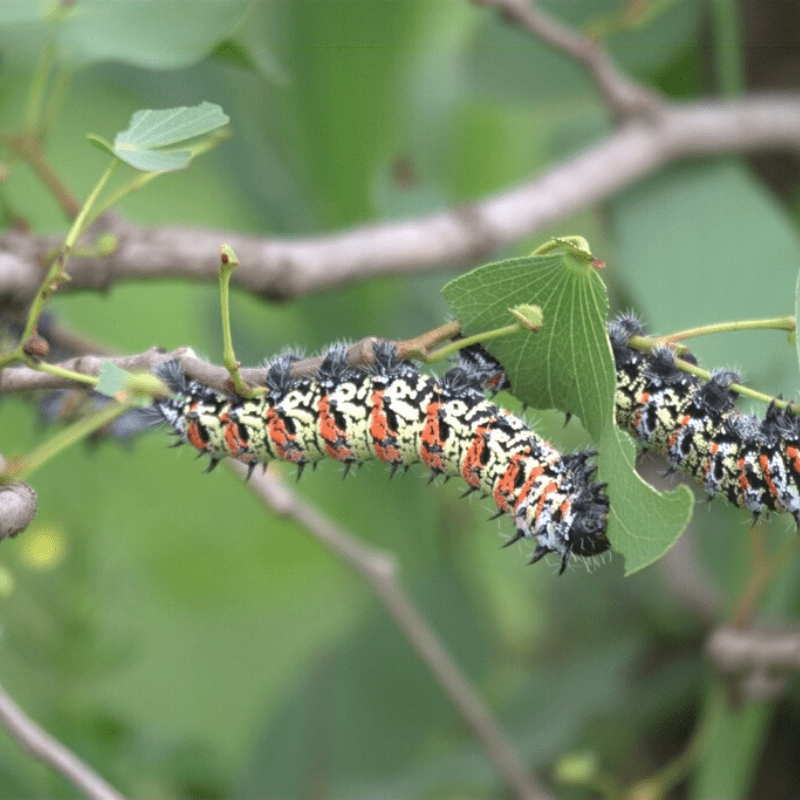Mopane Tree
(Colophospermum mopane)
Family: Fabaceae
Common names: mopane, turpentine tree (Eng.); mopanie (Afr.); mohlanare (Northern Sotho); mophane (Tswana)
SA Tree No: 198
These beautiful trees with their distinctive butterfly-shaped leaves and strange seeds are, for many, the essence of South Africa's lowveld areas, along with interesting bird and insect life and game animals. They are also an extremely important food source for animals and people. Vast tracts of uninterrupted mopane scrub and woodland characterise the hot, low-lying areas near the Limpopo River in the far north of South Africa.
Description
The mopane can be a shrub or a tall tree up to 30 m in the northern part of its range, depending on soil conditions and water availability. It has a tall, narrow crown. The compound leaves are divided in two so that the leaflets resemble butterfly wings or a camel's foot. There is a tiny point at the join of the two leaflets which is the remnant of a third, terminal leaflet. Crushed leaves have a turpentine odour. It is a deciduous (sometimes semi-deciduous) tree with lovely autumn and spring colours. Sprays of small, green flowers appear in December and January. These are followed by pods which ripen between April and June and are flat and somewhat kidney-shaped. They change from green to light, finely speckled brown. The flat seeds inside are sticky from resin exuded by glands which cover them. The strange appearance of the seeds is from the convolutions in their surface. Some might say they resemble tiny, flat mottled-brown brains! The greyish brown bark is very deeply fissured in vertical fissures. It has a rough, ropey appearance and is very distinctive.
Derivation of name and historical aspects
The name Colophospermum is Greek for oily seed, in reference to the resinous seeds. The part of the name, colophos, apparently refers to the strong turpentine smell of the resin. Colophony is another name for rosin, a substance obtained from turpentine. The species name, mopane, is taken from the local name for the tree. The genus Colophospermum only occurs in Africa and there is only one species in the genus. The mopane is in the pea family (Fabaceae). This huge and important family is further divided into three subfamilies; the mopane lies within the Caesalpinioideae. The other two subfamilies are the Mimosoideae, which contains amongst other genera the acacias; and the subfamily Papilionoideae into which plants such as the indigos (Indigofera) and rooibos tea bush (Aspalathus) are placed. C. mopane can be confused with the small false mopane, Guibourtia conjugata in areas where they co-occur (in the far northeast corner of South Africa), although the seeds of the false mopane are not convoluted or resinous and the bark not as rough and fissured. The leaves also do not have the tiny spike-like remnant of the third leaflet.
Ecology
If you were to travel through areas of mopane woodland in the heat of the day and wished to stop and rest in the shade, you would have trouble finding any! To save water, the leaflets fold together and present the smallest surface area toward the sun, thereby reducing exposure of the leaf surface. This also prevents much shade from being cast. The mopane is often deciduous in winter, possibly another adaptation to drought, since winters are not very cold in the lowveld, but they are dry. The lovely reddish new leaves only emerge in October in anticipation of the first rains. Game animals, particularly elephants, enjoy the protein-rich leaves and pods. Elephant pressure may be part of the reason for the stunted appearance of some areas of mopane scrub. Domestic animals find the pungent leaves unpalatable at first but will feed on them once used to the taste, and their meat and milk is apparently untainted with a turpentine flavour. The young leaves have a higher protein content and are more palatable, but even the dry, fallen leaves yield valuable protein for stock and game.
Hole-nesting birds such as hornbills favour mopane woodlands as they offer many nesting sites. 'Mopane manna' is picked off the leaves by people and baboons. This is a sweet-tasting, waxy cover on the juvenile stage of a sap-sucking insect (related to leaf-hoppers) known as the mopane psyllid, Arytaina mopani. The well-known mopane worm, which is the large caterpillar of the Imbrasia belina emperor moth, the Gonometa moth and the caterpillar of the foxy charaxes butterfly, Charaxes jasius saturnus, feed on the mopane. The tiny mopane bee, Plebina denoita, which many know from its (sometimes successful) attempts at crawling into one's eyes, ears and nose, produces a small amount of edible honey. They make their nests in hollow trunks with a small wax tube as the opening to the outside. Mopane seed pods do not split open of their own accord and the seeds can germinate while still in the pod.
Uses
In summer the leaves of C. mopane are fed on by swarms of fat, dark greyish mopane worms, which can reach almost 10 cm long. These are rich in protein and are eaten by people, either roasted or dried. The sale of dried mopane worms is an important income source for many people, creating a local economy. Other traditional uses of the mopane tree include the making of houses and kraal fences, the chewing of twigs as tooth brushes, the use of bark to make twine and for tanning, and the use of leaves for healing wounds. The hard, reddish heartwood timber was used to make railway sleepers and as props for mining activities. This is one South Africa's heaviest timbers and is apparently difficult to work because of its hardness, but this also makes it termite-resistant, therefore a popular choice for fence posts and flooring. The Gonometa moth caterpillar spins silken cocoons which are harvested as wild silk to make cloth.








